Ampelous begonia: what is it like and how to care for it at home?

Ampel begonia is considered one of the most beautiful flowers. Florists love it very much, because it can be used to decorate not only window sills, but also used to decorate a garden or a gazebo. The material in this article will tell you what it is, and how to properly care for it at home.
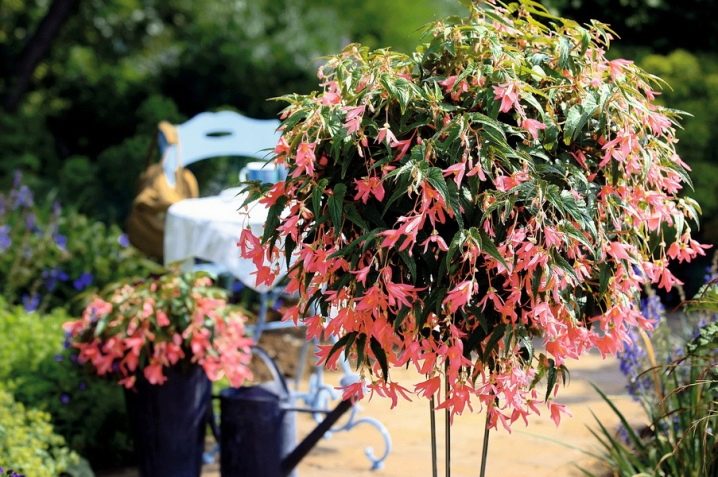
Description
Ampelous begonias include many varieties of flowers that are united by the length of the shoots. During the flowering period, these plants are strewn with flowers that look down. As a rule, the plant has unisexual flowers that bloom very actively and profusely. Their color can be very diverse, depending on the variety. Ampel begonia belongs to the class of tuberous perennial plants, characterized by succulent stems and asymmetrical spotted leaves. Depending on the variety of the variety, the height of the plant stem can be 20-60 centimeters. Moreover, the length of the leaves can vary from 10 to 20 cm.
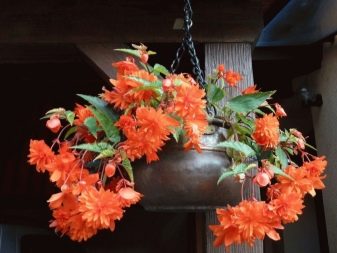
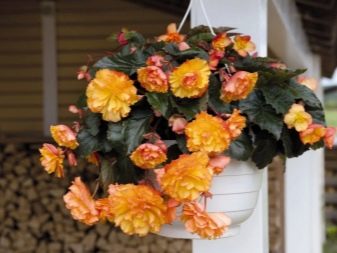
Despite the fact that each flower blooms for no more than 10 days, the plant is considered to be long-flowering. This is explained by the fact that after the faded, new flowers bloom. Therefore, with proper care, flowering at home can last almost all year. However, the plant also needs rest, and therefore in the winter period it needs rest. Flowers may vary in size, depending on the variety. In terms of color, they can be peach-pink, pink-white, orange, white, red, red-orange, yellow and dark scarlet. The color of the leaves is dark and light green, they have carved edges and a pointed top. Both leaves and flowers hang down from the pot.
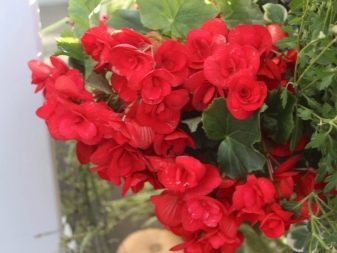
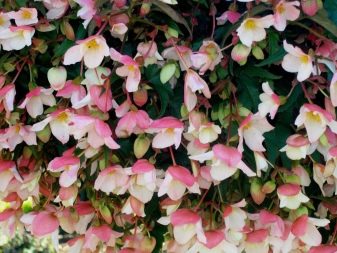
Varieties
To date, flower growers identify several of the most interesting varieties of ampel begonia, through which you can decorate the interior of a house and a gazebo. Each type has its own name and characteristics.
- Bellekonia - ampelous begonia with large double flowers of dark red or yellowish color. It has several varieties, blooms for more than a month, the flowers hold tight. Differs in high resistance to diseases and pests.
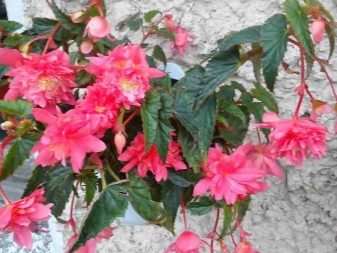
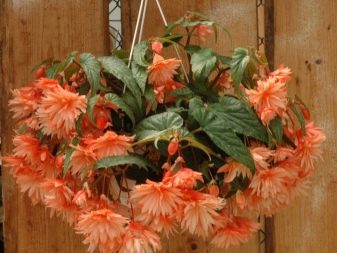
- "Chanson" - a variety with semi-double and double flowers, characterized by a camellia-like shape. The bush consists of five to eight shoots. The plant can be grown outdoors.
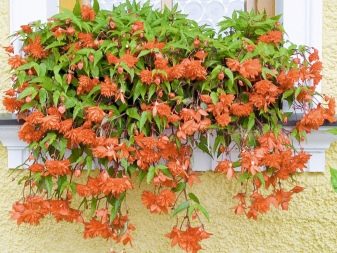
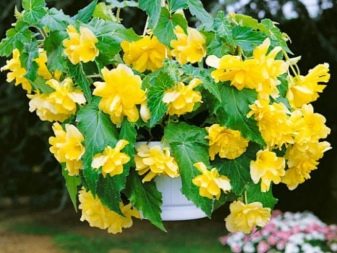
- "Venus F1" - a variety with long shoots and flowering until the very frost. Picky about watering, the size of the flowers is 6 cm. It is distinguished by the beauty of pink-white double flowers.
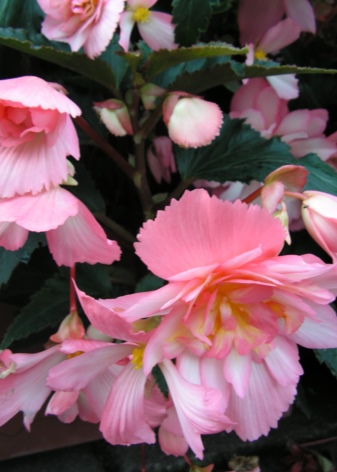

- "Alcor" is a variety with fleshy shoots and rich leaves. This species is distinguished by flowering from May to October, actively responds to fertilizing with mineral and organic fertilizers. The shape of the flowers is camellia, the color changes from the middle from pale pink to salmon.
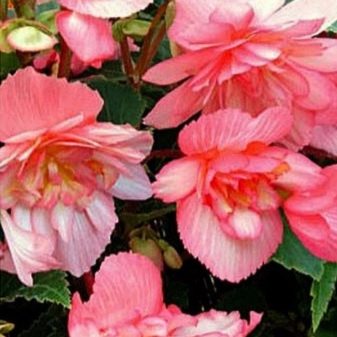
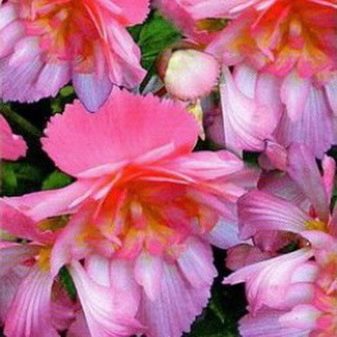
- "Hip-hop" - ampelous mixture with a flower size of 6 to 8 cm. It is a hybrid with double and semi-double flowers. The length of the stems reaches 40–45 cm, the plant loves fertile soil with a slightly acidic reaction.
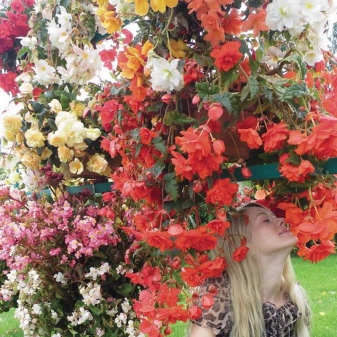
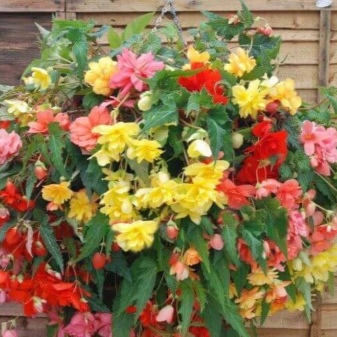
- "Carmen" - a variety with dark red flowers and hanging shoots up to 40 cm long. Differs in fast-growing lush greenery, looks good in a hanging planter, a vase on a leg or a basket.Suitable for planting on a flower bed, as a decoration for a veranda, gazebo and even a terrace.
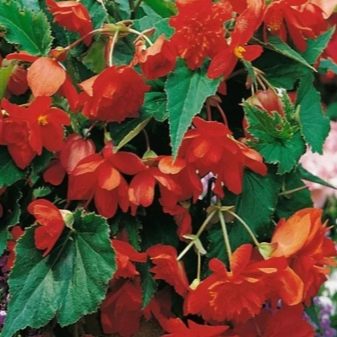
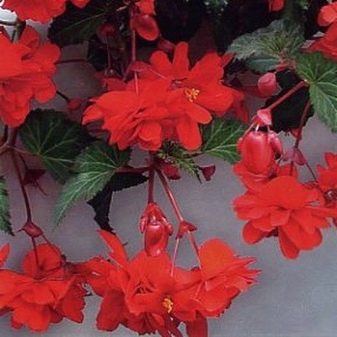
- Illumination it is distinguished by an abundance of buds, which bloom into beautiful white double flowers and cascade down thin stems. It has a tuberous root system, long and thin shoots, and medium-sized leaves with an asymmetrical shape.
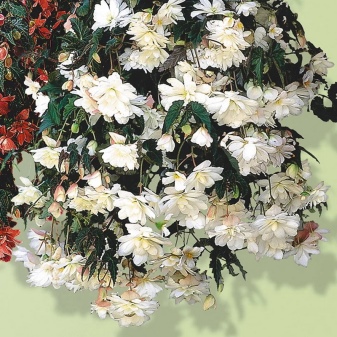
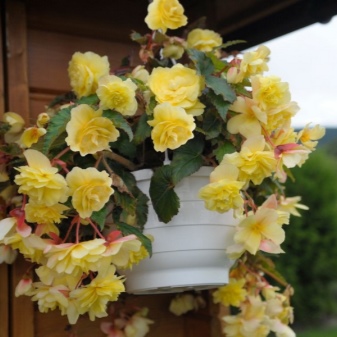
- "Sun dancer" - a variety that differs from other varieties of ampelous begonias in the large number and size of flowers. It curls well, and also quickly enough fills baskets or other suspensions, forming cascades of flowering buds.
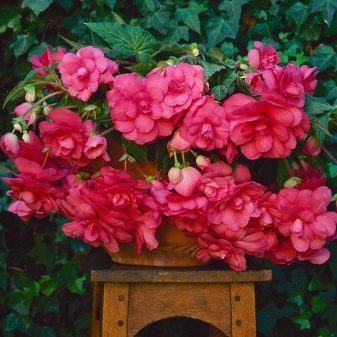

- "Chardonnay" - a kind of "Bellekonia", which belongs to the newest series of ampel begonias. An incredibly beautiful and large variety that blooms until late autumn. Differs in the formation of flowers at the level of the fifth to sixth leaf node.
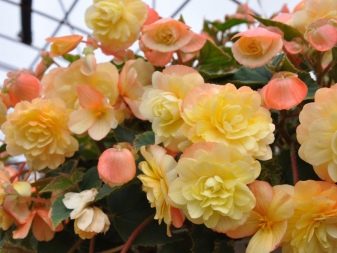

- Soft Orange also belongs to the category of "Bellekonia", is distinguished by a bright orange color of double flowers. In comparison with other types of ampel begonias, the variety is considered expensive.

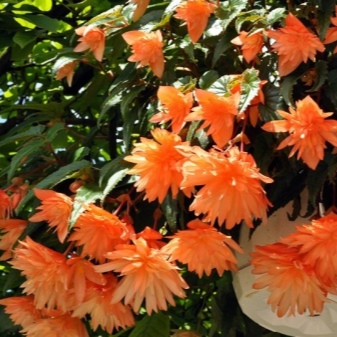
- "Pink" grows in length up to 30 cm, has thin stems and leaves of pale green color. The flowers are bright pink, medium-sized, quickly hang down, like the stems. Designed for hanging pots and baskets.
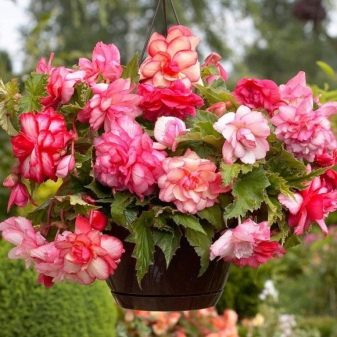
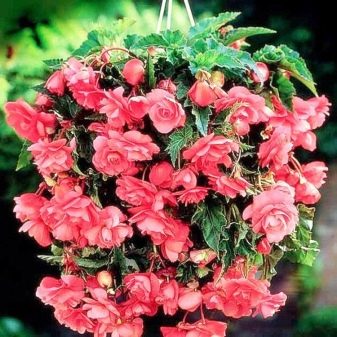
Landing
Growing ampelous begonia is a troublesome task, especially considering that the stems are very delicate and fragile, it reacts to any climate change. Therefore, you will have to monitor not only the illumination and temperature conditions, but also the choice of the right soil.
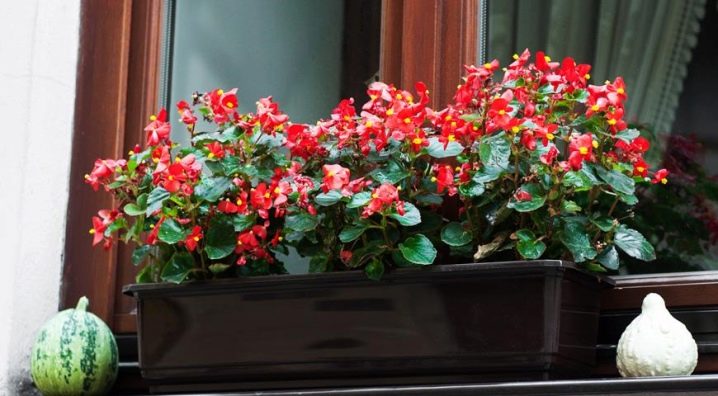
Choosing a substrate
Sowing begonias should be in a substrate consisting of a mixture of sand, leafy soil and turf in a ratio of 1: 4: 1. If possible, you can buy a special soil mixture for begonias in a flower shop. Sowing is necessary at the end of January, so you can take care of the substrate in advance by preparing its components in the fall. Other gardeners, given the longevity of flowering, plant begonia in February. Ampel begonia loves nutritious and loose soil. Before planting it, you will have to treat the soil with a fungicide.

We select tubers
When starting planting, it is important to understand that a high-quality specimen of a plant can be grown if a large and healthy tuber was originally planted. Therefore, the choice of planting material should be approached with special care. For example, you need to choose a healthy tuber in a flower shop, the diameter of which will exceed 3 cm. If you plan to grow an ampelous beauty with small flowers, you need to pay attention to the peeled specimens of tubers that the seller offers.
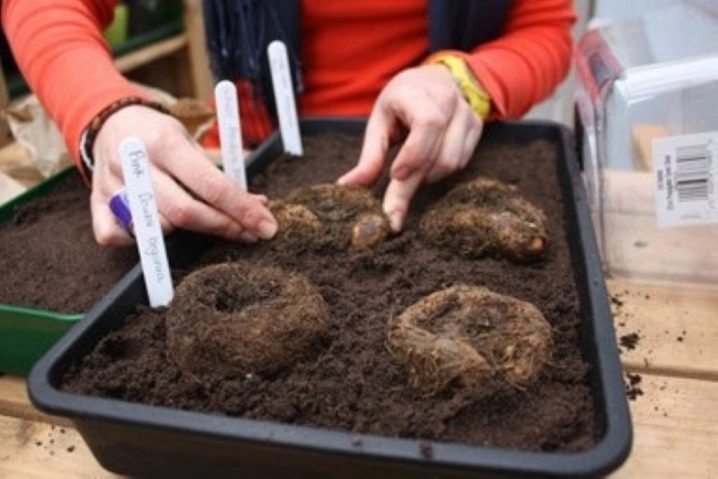
They should not be stained or damaged in any way. In this case, the surface of the planting material should be dense. In addition, there should be no damage to the buds themselves, which look like tubercles.
Preparing planting material
Before planting the tubers in the prepared soil, they must be kept with the lower (protruding) side on a cloth dipped in water. If you wish, you can replace the fabric with regular damp sand. To prevent the disappearance of the tuber, it will have to be periodically moistened with water or sprayed with Epin solution. When tiny roots appear from the buds, you can start planting.

We plant
Before planting, you need to prepare a container: a wide and shallow pot is suitable for begonias. In this case, it is extremely important that there are drainage holes in it to drain excess water. Before pouring earth into the container, a drainage layer is placed on the bottom. You can use chipped shards and expanded clay. It is important that the soil is breathable. Immediately before planting, it is necessary to moisten the soil by spraying it from a spray bottle. It is impossible to overfill it - this will harm the tubers. You need to plant the tubers with the side down where the roots appear. After that, the tubers are sprinkled with earth, but do not cover them on top. This can only be done after the sprouts appear.
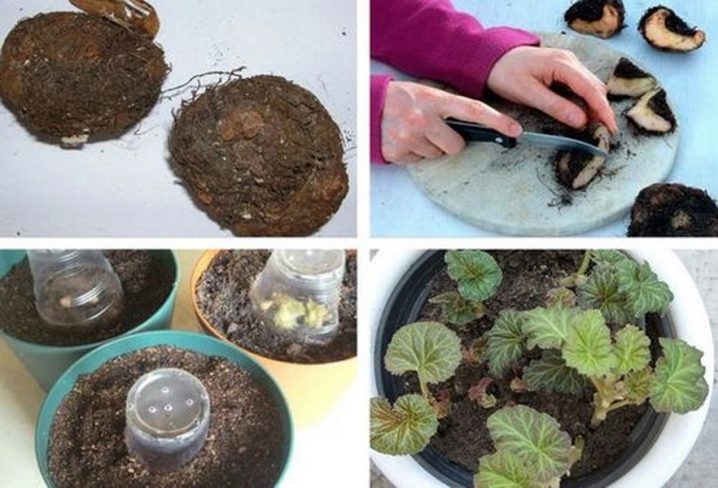
Temperature regime
Ampel begonia is a capricious plant, it is demanding for a certain temperature regime. For comfortable growth and development, he needs that the temperature in the room does not exceed + 18-20 degrees. If necessary, she can tolerate a slight drop in temperature for some time. During the flowering period, the temperature may slightly increase (up to a maximum of +25 degrees). In the summer season, the plant can be taken out on the veranda, loggia or balcony. But it must be remembered that fragile stems, like flowers, can be damaged by the wind.
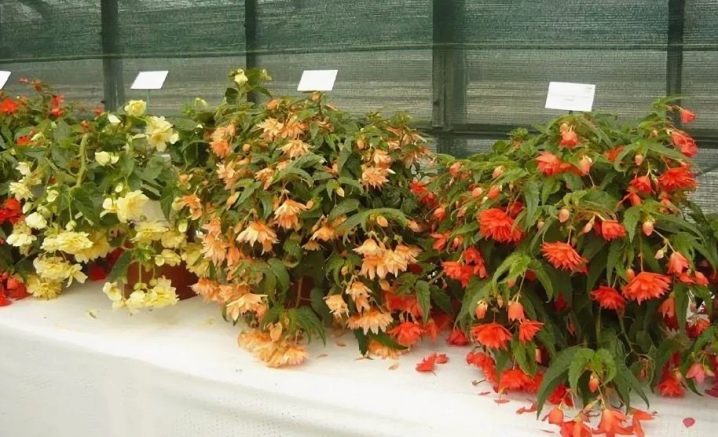
Humidity
The plant dies at low air humidity. It is advisable to place the flower where it will be possible to humidify the air. You can place the flower next to a tray of peat that is systematically moistened. Otherwise, you can spray the air itself around the flower, trying not to get on the leaves and flowers. In the heat, dry air should not be allowed.
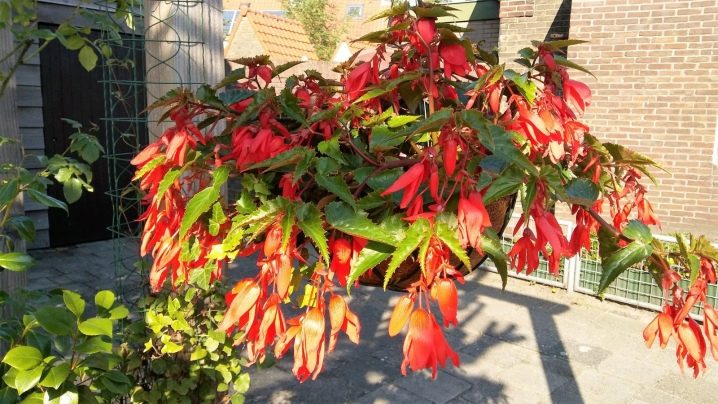
Watering
Watering begonias differs from other plants. While the tuber is just planted, you cannot pour water on it. You need to water the flower sparingly, since the tubers will begin to rot from an excess of moisture. However, it is also impossible to dry out the earthen lump - this leads to the death of the plant.
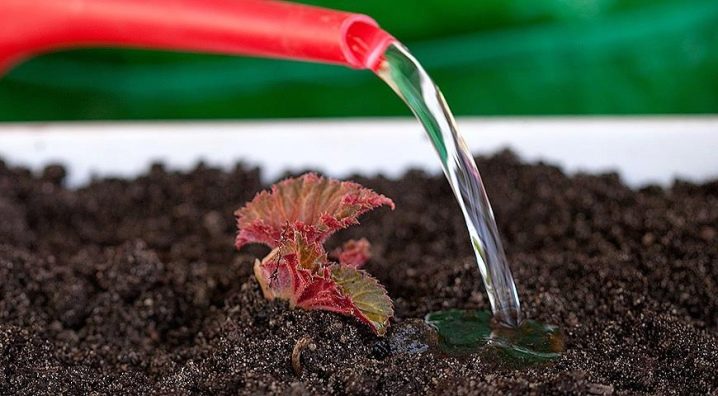
Do not water the begonia with too cold water. In the summer, you can put it outside so that it naturally warms up. From time to time, you can spray the leaves with water at room temperature by removing the plant from the windowsill. You need to water the flower closer to the edges of the pot, using settled water for this.
The regularity of watering depends on the season. In summer, watering should be more frequent, closer to winter, its frequency and volume are reduced. Watering the plant is necessary when the topsoil dries up. At this time, there will be no flowering, however, the leaves with regular watering will look juicy and lively. You cannot put the plant close to the radiators for the winter, since this dries up the substrate faster than it should be.
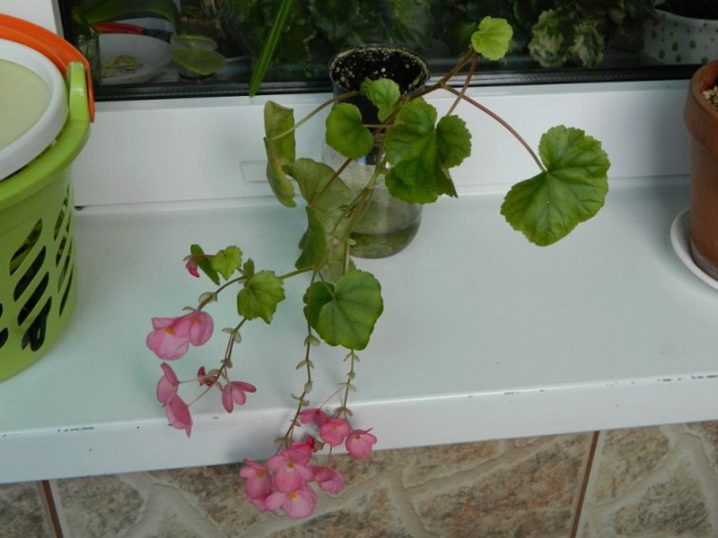
Care
Ampelous begonia is considered a light-loving plant. Therefore, it must be grown in a bright room, but you cannot put a flowerpot in the sun: direct sunlight can cause leaf burns. Lighting should be diffused and soft. If there is insufficient light, the leaves may fade. Despite the fact that the flower is literally filled with stems and flowers, it is afraid of wind and drafts. Therefore, placing it in such places is unacceptable. In order to maintain its aesthetic appeal, it must be moisturized. You can also water the plant directly into the pallet. The ideal condition for the growth and development of begonia is light partial shade.
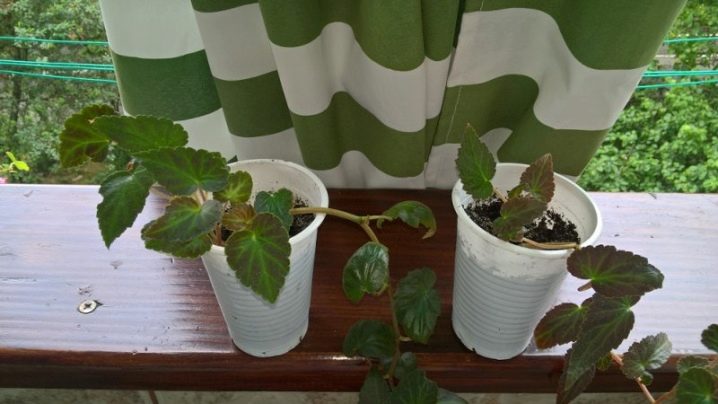
If the flower is deficient in sunlight, it may not bloom at all. It is necessary to grow it at home in a place where it is not hot and not windy. During the flowering period, it is advisable to feed begonia. From this, the plant blooms longer and more abundantly (for example, flowering can last from May to November).
However, despite the fact that liquid or complex fertilizer can be used as top dressing, it should not be nitrogenous. Such nutritional complexes provoke the growth of leaves, due to which the flowers simply do not have the strength to open and bloom. On average, the dormant period is just over three months. At this time, it is undesirable to often touch the plant, it is enough just to moisturize it.

How to keep in winter?
In winter, begonia stems can stretch out. In order for the plant to start growing again in spring, the stems are cut in February, leaving 4 internodes on each of them. Sometimes wintering at home is accompanied by the death of the aerial part of the plant. To an unenlightened layman it may seem that the flower has died, however, in reality this is not so. In this case, the begonias need rest, and they simply went into hibernation. Therefore, the container with the tuber should be removed to a cool place where the temperature is maintained at about +15 degrees.From time to time, you need to moisten the soil and make sure that it does not dry out. It is not necessary to remove the tuber from the ground and even more so to cut off the remaining (not dead) aerial part.
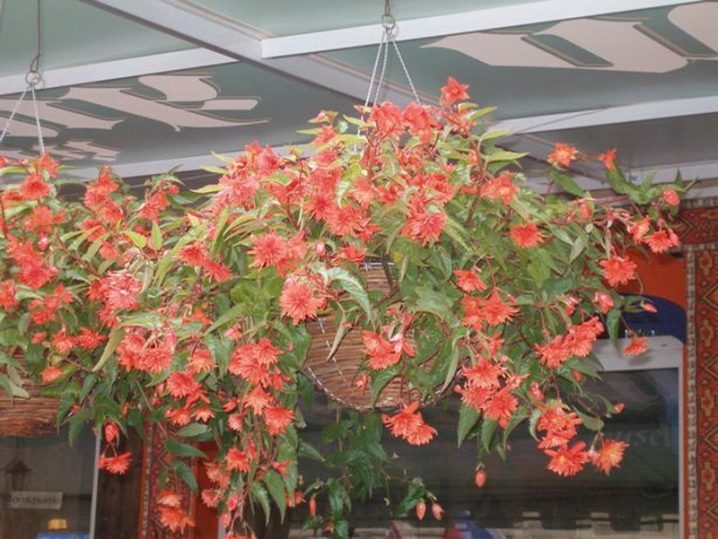
Reproduction
You can propagate ampelous begonia with tubers, cuttings and seeds. In this case, the latter is considered the most time-consuming method. The seeds of the plant are tiny, and therefore need special attention when planting. Sow them into a pre-prepared and moistened substrate without deepening. After that, the container is covered with plastic wrap and removed for germination.
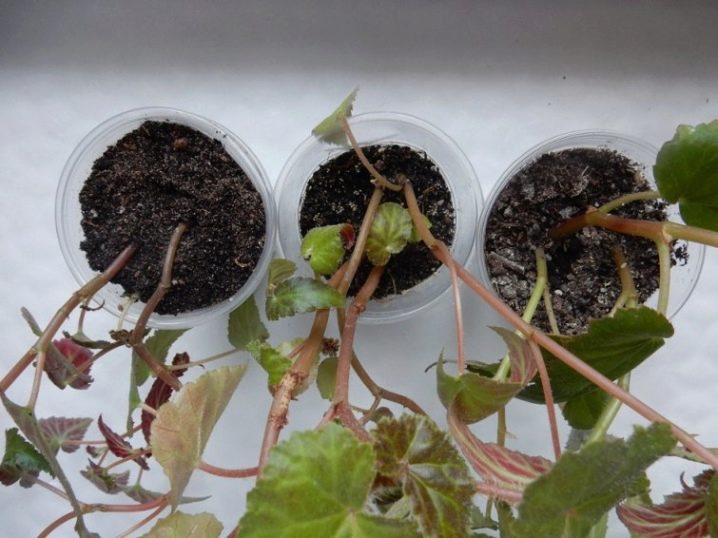
Instead of a film, you can also use transparent glass. It is necessary to keep the sowing under glass until the moment of the first pick. All the time during germination, it is important to ensure that the soil in the container does not dry out. You can moisten the sprouts through the tray by pouring warm, settled water into it. A pick can be carried out at the stage when the sprout has two or three leaves.
To propagate the ampelous begonia by cuttings, it is necessary to separate the ten-centimeter cuttings of the overwintered plantby placing them in water until sprouts form. After that, they are transplanted into the ground, containing 5 pieces in one pot. If you want to try the tuber propagation method, you need to cut off a small part from the tuber, on which two or three buds should be located. Next, you need to treat it with powdered crushed coal or colloidal sulfur. After the tuberous parts with buds are dry, they can be planted in pots according to the traditional scheme discussed at the beginning of the article.
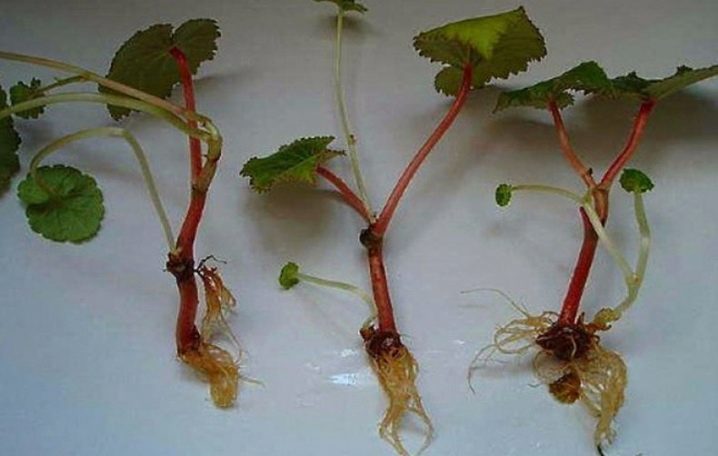
Possible problems
When growing begonias, you can face such troubles as diseases and pests. For example, you may notice that begonia has shed its leaves or they turn white. Let's note the most common problems.
- Sometimes the leaves and stems of the plant are affected by gray rot, from which they begin to rot.
- If a whitish bloom appears on the leaves, this indicates the defeat of begonia with powdery mildew.
- If the disease manifests itself on the underside of the leaves, this means that the begonia suffers from bacterial spotting and must be treated with a special preparation.
- You can cope with aphids and whiteflies by spraying, using a drug to get rid of a specific pest.
- If the plant is attacked by a red spider mite, the leaves curl up and become covered with yellow spots. It is necessary to treat the plant with a systemic insecticide.
- If the soil is acidic, you need to pay attention to the capacity. Begonia has a shallow root zone, the pot should be low, but not low either.
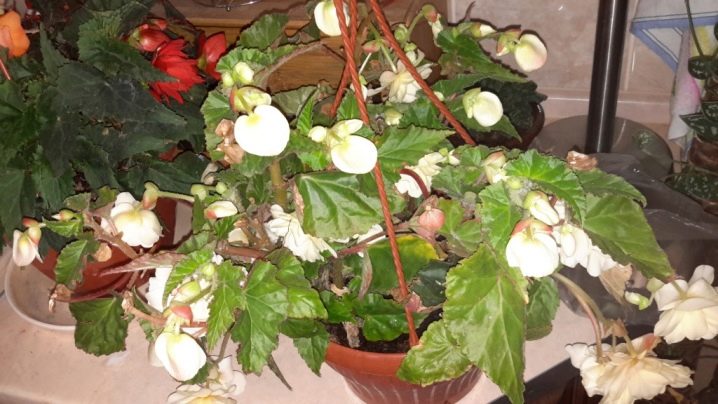
To avoid the difficulties of sowing, you can use granulated seeds when planting. They are supplied with a nutritious membrane, due to which they are larger and more convenient for planting. Moreover, they can be planted in peat tablets, which eliminates the need for a mandatory pick.
Examples in the interior
We suggest referring to examples of photo galleries that clearly demonstrate how ampelous begonia can change the perception of space.
- Fresh greenery and double flowers bring life to the small space.
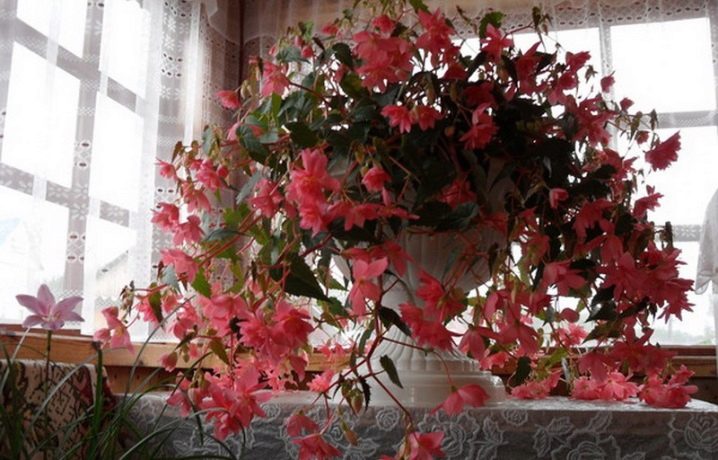
- White begonia flowers are able to harmoniously fit into the interior of any style.
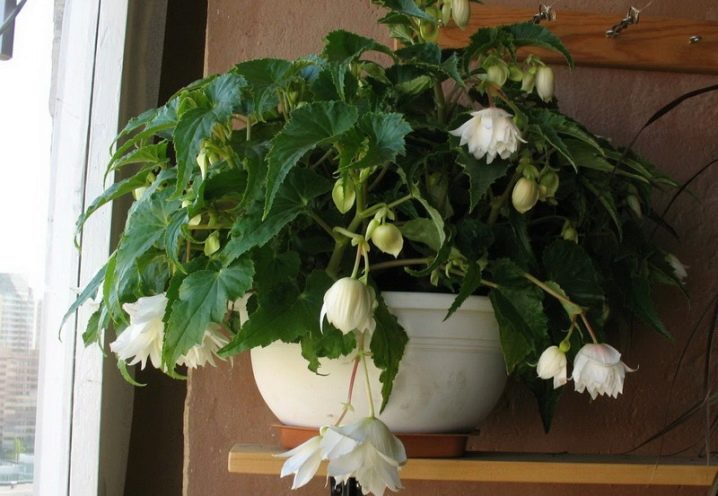
- The design of the room, complemented by fresh flowers, looks beautiful and harmonious.
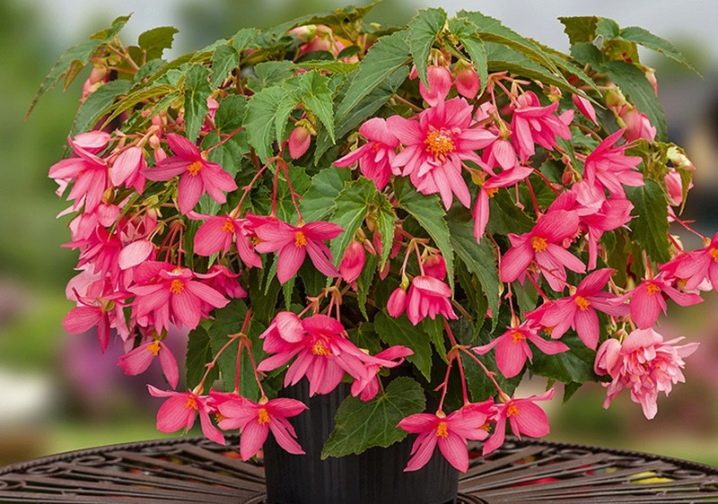
- Bright flowers can make the atmosphere of the room truly cozy.

- Delicate double flowers with fresh greenery can rightfully be called the best accessory for an interior composition.
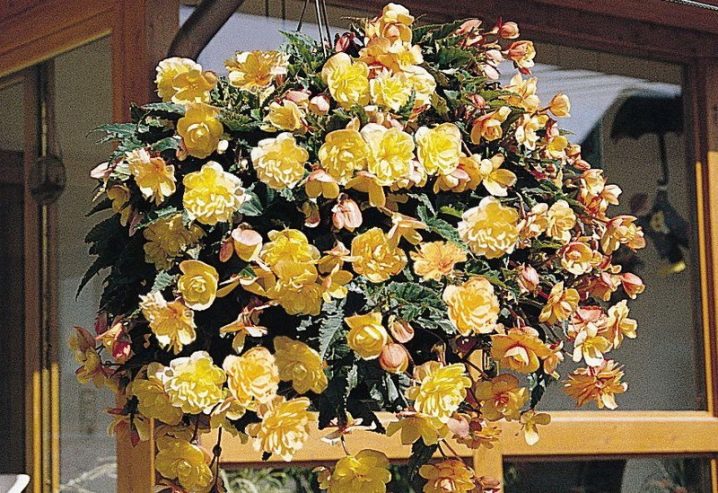
- Begonias in hanging pots can decorate the veranda.

For information on how to properly care for ampelous begonia, see the next video.































Great! Thanks! The best story about begonias. Everything is clear and understandable.
The comment was sent successfully.